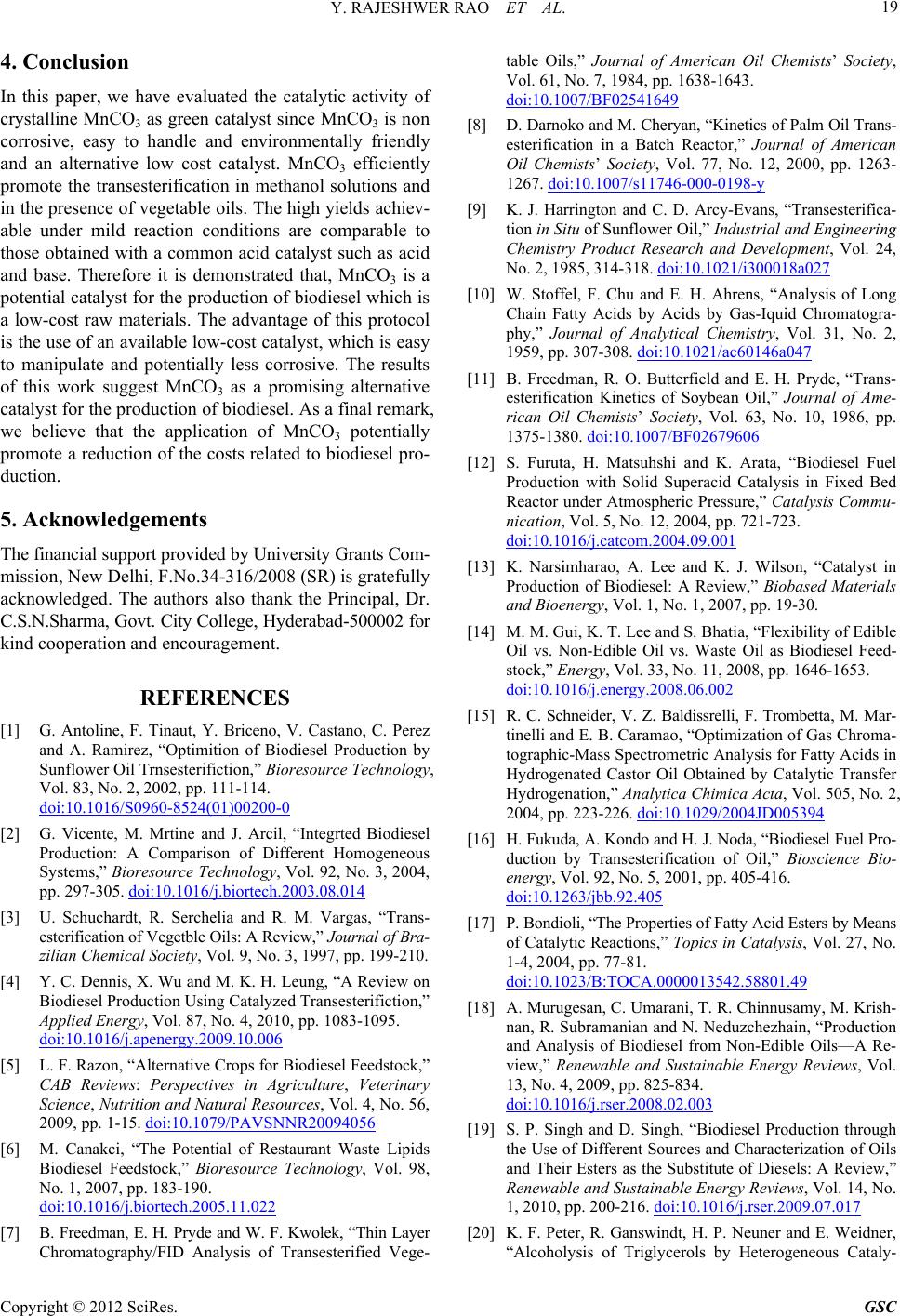
Y. RAJESHWER RAO ET AL. 19
4. Conclusion
In this paper, we have evaluated the catalytic activity of
crystalline MnCO3 as green catalyst since MnCO3 is non
corrosive, easy to handle and environmentally friendly
and an alternative low cost catalyst. MnCO3 efficiently
promote the transesterification in methanol solutions and
in the presence of vegetable oils. The high yields achiev-
able under mild reaction conditions are comparable to
those obtained with a common acid catalyst such as acid
and base. Therefore it is demonstrated that, MnCO3 is a
potential catalyst for the produ ction of biodiesel which is
a low-cost raw materials. The advantage of this protocol
is the use of an available low-cost catalyst, which is easy
to manipulate and potentially less corrosive. The results
of this work suggest MnCO3 as a promising alternative
catalyst for the produ ction of biodiesel. As a final remark ,
we believe that the application of MnCO3 potentially
promote a reduction of the costs related to biodiesel pro-
duction.
5. Acknowledgements
The financial support provided by University Grants Com-
mission, New Delhi, F.No.34-316/2008 (SR) is gratefully
acknowledged. The authors also thank the Principal, Dr.
C.S.N.Sharma, Govt. City College, Hyderabad-500002 for
kind cooperation and encouragement.
REFERENCES
[1] G. Antoline, F. Tinaut, Y. Briceno, V. Castano, C. Perez
and A. Ramirez, “Optimition of Biodiesel Production by
Sunflower Oil Trnsesterifiction,” Bioresource Technology,
Vol. 83, No. 2, 2002, pp. 111-114.
doi:10.1016/S0960-8524(01)00200-0
[2] G. Vicente, M. Mrtine and J. Arcil, “Integrted Biodiesel
Production: A Comparison of Different Homogeneous
Systems,” Bioresource Technology, Vol. 92, No. 3, 2004,
pp. 297-305. doi:10.1016/j.biortech.2003.08.014
[3] U. Schuchardt, R. Serchelia and R. M. Vargas, “Trans-
esterification of Vegetble Oils: A Review,” Journal of Bra-
zilian Chemical Society, Vol. 9, No. 3, 1997, pp. 199-210.
[4] Y. C. Dennis, X. Wu and M. K. H. Leung, “A Review on
Biodiesel Production Using Catalyzed Transesterifiction,”
Applied Energy, Vol. 87, No. 4, 2010, pp. 1083-1095.
doi:10.1016/j.apenergy.2009.10.006
[5] L. F. Razon, “Alternative Crops for Biodiesel Feedstock,”
CAB Reviews: Perspectives in Agriculture, Veterinary
Science, Nutrition and Natural Resources, Vol. 4, No. 56,
2009, pp. 1-15. doi:10.1079/PAVSNNR20094056
[6] M. Canakci, “The Potential of Restaurant Waste Lipids
Biodiesel Feedstock,” Bioresource Technology, Vol. 98,
No. 1, 2007, pp. 183-190.
doi:10.1016/j.biortech.2005.11.022
[7] B. Freedman, E. H. Pryde and W. F. Kwolek, “Thi n Layer
Chromatography/FID Analysis of Transesterified Vege-
table Oils,” Journal of American Oil Chemists’ Society,
Vol. 61, No. 7, 1984, pp. 1638-1643.
doi:10.1007/BF02541649
[8] D. Darnoko and M. Cheryan, “Kinetics o f Palm Oil Trans-
esterification in a Batch Reactor,” Journal of American
Oil Chemists’ Society, Vol. 77, No. 12, 2000, pp. 1263-
1267. doi:10.1007/s11746-000-0198-y
[9] K. J. Harrington and C. D. Arcy-Evans, “Transesterifica-
tion in Situ of Sunflower Oil,” Industrial and Engineering
Chemistry Product Research and Development, Vol. 24,
No. 2, 1985, 314-318. doi:10.1021/i300018a027
[10] W. Stoffel, F. Chu and E. H. Ahrens, “Analysis of Long
Chain Fatty Acids by Acids by Gas-Iquid Chromatogra-
phy,” Journal of Analytical Chemistry, Vol. 31, No. 2,
1959, pp. 307-308. doi:10.1021/ac60146a047
[11] B. Freedman, R. O. Butterfield and E. H. Pryde, “Trans-
esterification Kinetics of Soybean Oil,” Journal of Ame-
rican Oil Chemists’ Society, Vol. 63, No. 10, 1986, pp.
1375-1380. doi:10.1007/BF02679606
[12] S. Furuta, H. Matsuhshi and K. Arata, “Biodiesel Fuel
Production with Solid Superacid Catalysis in Fixed Bed
Reactor under Atmospheric Pressure,” Catalysis Commu-
nication, Vol. 5, No. 12, 2004, pp. 721-723.
doi:10.1016/j.catcom.2004.09.001
[13] K. Narsimharao, A. Lee and K. J. Wilson, “Catalyst in
Production of Biodiesel: A Review,” Biobased Materials
and Bioenergy, Vol. 1, No. 1, 2007, pp. 19-30.
[14] M. M. Gui, K. T. Lee and S. Bhatia, “Flexibility of Edible
Oil vs. Non-Edible Oil vs. Waste Oil as Biodiesel Feed-
stock,” Energy, Vol. 33, No. 11, 2008, pp. 1646-1653.
doi:10.1016/j.energy.2008.06.002
[15] R. C. Schneider, V. Z. Baldissrelli, F. Trombetta, M. Mar-
tinelli and E. B. Caramao, “Optimization of Gas Chroma-
tographic-Mass Spectrometric Analysis for Fatty Acids in
Hydrogenated Castor Oil Obtained by Catalytic Transfer
Hydrogenation,” Analytica Chimica Acta, Vol. 505, No. 2,
2004, pp. 223-226. doi:10.1029/2004JD005394
[16] H. Fukuda, A. Kondo and H. J. Noda, “Biodiesel Fuel Pro-
duction by Transesterification of Oil,” Bioscience Bio-
energy, Vol. 92, No. 5, 2001, pp. 405-416.
doi:10.1263/jbb.92.405
[17] P. Bondioli, “The Properties of Fatty Acid Esters by Means
of Catalytic Reactions,” Topics in Cataly sis, Vol. 27, No.
1-4, 2004, pp. 77-81.
doi:10.1023/B:TOCA.0000013542.58801.49
[18] A. Murugesan, C. Umarani, T. R. Chinnusamy, M. Krish-
nan, R. Subramanian and N. Neduzchezhain, “Production
and Analysis of Biodiesel from Non-Edible Oils—A Re-
view,” Renewable and Sustainable Energy Reviews, Vol.
13, No. 4, 2009, pp. 825-834.
doi:10.1016/j.rser.2008.02.003
[19] S. P. Singh and D. Singh, “Biodiesel Production through
the Use of Different Sources and Characterization of Oils
and Their Esters as the Substitute of Diesels: A Review,”
Renewable and Sustainable Energy Reviews, Vol. 14, No.
1, 2010, pp. 200-216. doi:10.1016/j.rser.2009.07.017
[20] K. F. Peter, R. Ganswindt, H. P. Neuner and E. Weidner,
“Alcoholysis of Triglycerols by Heterogeneous Cataly-
Copyright © 2012 SciRes. GSC